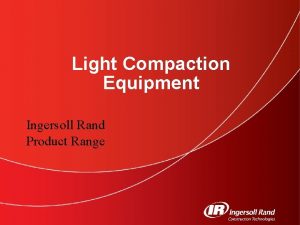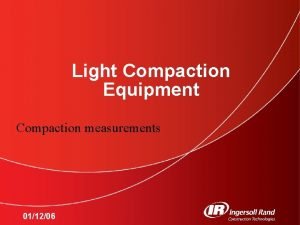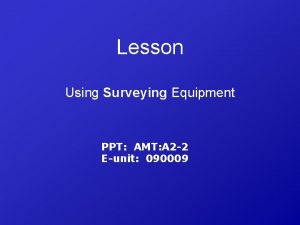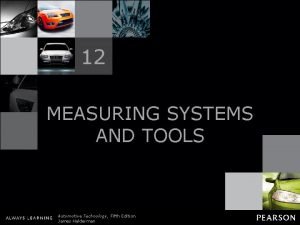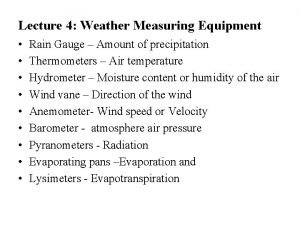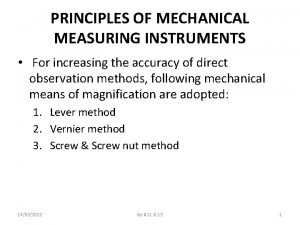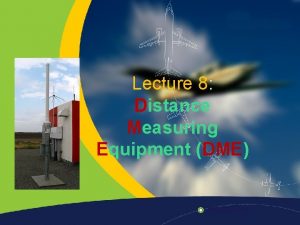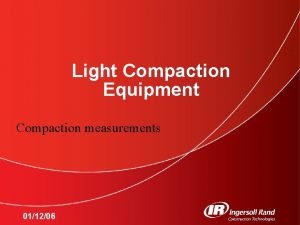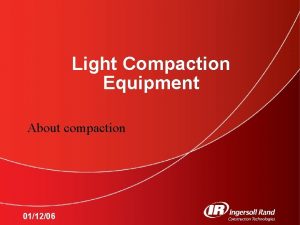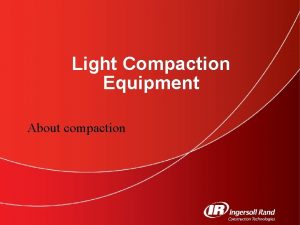Light Compaction Equipment Compaction measurements 011206 Measuring compaction









- Slides: 9

Light Compaction Equipment Compaction measurements 01/12/06

Measuring compaction • Soil compaction is among the most complex processes in the construction techniques: Whether a compaction work is efficient or not is not obvious to tell at first sight. • It is first necessary to determine a reference to compare with: This is the objective of the Proctor test applied to a soil sample. • It is time afterwards to measure the compaction on the jobsite. Several techniques exist: – Physical soil density measurement: § Sand Cone § Balloon Density Meter § Shelby Tube – Nuclear Gauge density measurement. – Soil stiffness 2 Light Construction Utility Equipment

Proctor test • A compaction measurement is only valid when it is looked at in relation with a reference value: the value defined by the Proctor test. • E. g. Two different types of soil, A and B. A is recognized to have a good stability (bearing) properties when its density reaches 3 kg/dm³. B, which is of a heavier composition, will be stable when compacted at 4 kg/dm³. These “ 100% density” values are actually determined by the Proctor Test. A • Composition A B X Poctor max dens. 3 kg/dm³ 4 kg/dm³ ? kg/dm³ Sample meas. d. 2. 7 kg/dm³ Relative density 90 % B Taking a sample of soil A on a jobsite and measuring a density of 2. 7 kg/dm³, we can tell that its compacity is of 90%. (The general contractor will usually settle the compaction objective as a percentage value of the Proctor reference: 97% or 98 %) 3 Light Construction Utility Equipment

Proctor test • In most cases, the soil composition of a jobsite is not known. It is necessary to realize a Proctor test in a laboratory in order to measure the reference (100%) density value. • It is defined as the density after the following treatment of the dry soil: 2. 495 kg 30. 5 cm 0. 94 dm³ 4 Light Construction Utility Equipment

Compaction measurement Density measurement: Sand cone • A small cubic hole (~ 6” side, ~ 15. 2 cm) is dug in the compacted soil to be tested. The soil is removed, weighed, then dried and weighed again to determine its moisture content. – Moisture = Water wt / Dry soil wt. • The exact volume of the hole is measured by pouring dry sand in the hole using the sand cone. • The soil sample density is easily calculated by dividing the dry weight and the volume [kg/dm³]. • This value is compared with the maximum Proctor density to calculate the relative density [%]. 5 Light Construction Utility Equipment

Compaction measurement Density measurement: Core test • The principle of density calculation is very similar to the sand cone. • But there is no volume measurement to be done since the inside volume of the cylinder that will remove the sample is calibrated. 6 Light Construction Utility Equipment

Compaction measurement Nuclear Gauge • The meter uses a radioactive isotope source (Cesium 137) at the soil surface or from a probe placed into the soil (direct transmission). • The isotope source gives off photons (γ rays) which radiate back to the mater’s detectors on the bottom of the unit. • Dense soil absorbs more radiation than loose soil and the readings reflect overall density. • Water content can also be read, all within a few minutes. 7 Light Construction Utility Equipment

Compaction measurement Soil Stiffness • This field-test method is a very recent development that replaces soil density testing. • Soil stiffness is the ratio of force-to-displacement. • Testing is done by a machine that sends vibrations into the soil and then measures deflection of the soil from the vibrations. • This is a very fast, safe method of testing soil stiffness. • There are chances in the future that the demand of the general contractor will not be anymore on the density but on soil stiffness. 8 Light Construction Utility Equipment

